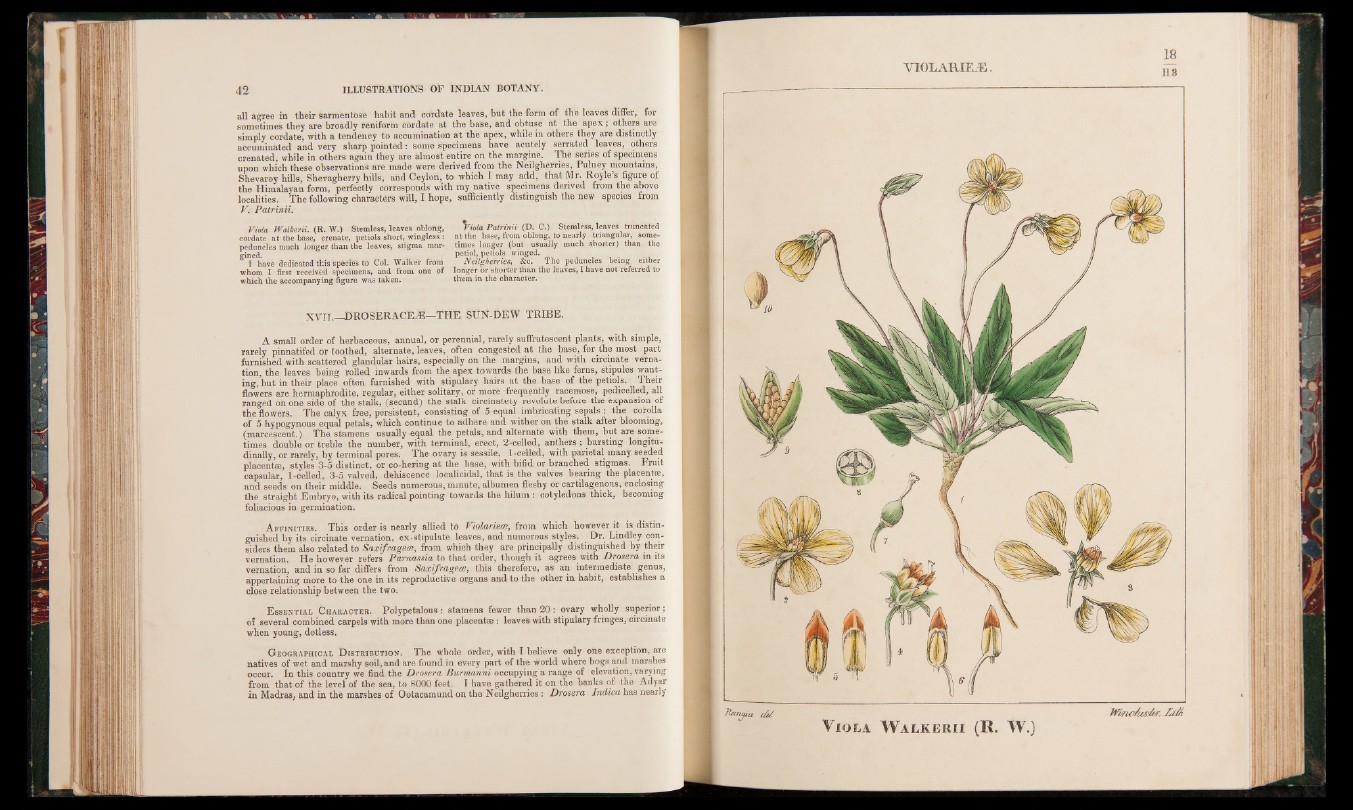
all agree in their sarmentose habit and cordate leaves, but the form of the leaves differ, for
sometimes they are broadly reniform cordate at the base, and obtuse at the apex; others are
simply cordate, with a tendency to accumination at the apex, while in others they are distinctly
accuminated and very sharp pointed: some specimens have acutely serrated leaves, others
crenated, while in others again they are almost entire on the margine. The series of specimens
upon which these observations are made were derived from the Neilgherries, Pulney mountains,
Shevaroy hills, Shevagherry hills, and Ceylon, to which I may add, that Mr. Royle’s figure of
the Himalayan form, perfectly corresponds with my native specimens derived from the above
localities. The following characters will, I hope, sufficiently distinguish the new species from
V. Patrinii.
Viola Walkerii. (R. W.) Stemless, leaves oblong,
cordate at the base, crenate, petiols short, wingless :
peduncles much ionger than the leaves', stigma margined.
I have dedicated this species to Cdl. Walker from
whom I first received specimens, and from one of
which the accompanying figure was taken.
\ io la Patrinii (D. G.) Stemless, leaves truncated
at the base, from oblong, to nearly triangular, sometimes
longer (but usually much shorter) than the
petiol, petiols winged.
Neilgherries, &c. The peduncles being either
longer or shorter than the leaves, I have not referred to
them in the character.
XVII._DROSËRACËA3—THE SÜN-DEW TRIBE.
A small order of herbaceous, annual, or perennial, rarely suffrutescent plants, with simple,
rarely pinnatifed or toothed, alternate, leaves, often congested at the base, for the most part
furnished with scattered glandular hairs, especially on the margins, and with circinate vernation,
the leaves being rolled inwards from the apex towards the base like ferns, stipules wanting,
but in their place often furnished with stipulary hairs at the base of the petiols. Their
flowers are hermaphrodite, regular, either solitary, or moré frequently racemose, pedicelled, all
ranged on one side of the stalk* (secund) the stalk circinatety revolute before the expansion of
the flowers. The calyx free, persistent, consisting of 5 equal imbricating sepals : the corolla
of 5 hypogynous equal petals, which continue to adhere and wither on the stalk after blooming,
(marcescent.) The stamens usually equal the petals, and alternate with them, but are sometimes
double or treble the number, with terminal, erect, 2-celled, anthers; bursting longitudinally,
or rarely, by terminal pores. The ovary is sessile, 1-celled, with parietal many seeded
placentae, styles 3-5 distinct, or co-hering at the base, with bifid or branched stigmas. Fruit
capsular, 1-celled, 3-5 valved, dehiscence loculicidal, that is the valves bearing the placentas,
and seeds on their middle. Seeds numerous, minute, albumen fleshy or cartilagenous, enclosing
the straight Embryo, with its radical pointing towards the hilum : cotyledons thick, becoming
foliacious in germination.
A ffin it ie s . This order is nearly allied to Violariece* from which however it is distinguished
by its circinate vernation, eX-stipulate leaves, and numerous styles. Dr. Lindley considers
them also related to Saxifrages, from which they are principally distinguished by their
vernation. He however refers Parnassia to that order, though it agrees with Drosera in its
vernation, and in so far differs from Saxifragece, this therefore, as an intermediate genus,
appertaining more to the one in its reproductive organs and to the other in habit, establishes a
close relationship between the two.
E ssential C haracter. Polypetalous: stamens fewer than 2 0 : ovary wholly superior;
of several combined carpels with more than one placentae: leaves with stipulary fringes, circinate
when young, dotless.
G eographical D istribution. The whole order, with I believe only one exception, are
natives of wet and marshy soil, and are found in every part of the world where bogs and marshes
occur. In this country we find the Drosera Burmanni occupying a range of elevation, varying
from that of the level of the sea, to 8000 feet. I have gathered it on the banks of the Adyar
in Madras, and in the marshes of Ootacamund on the Neilgherries: Drosera Indica has nearly
VIOLARIEiE.
18
113
Buncfia, del
Viola Walkerii (R. W.)
WdwAeshr. IdM